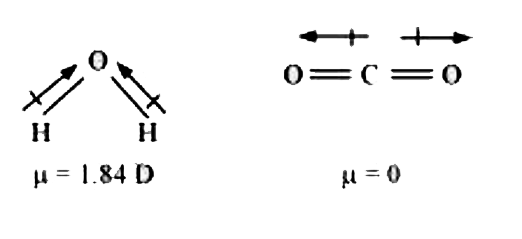Write the significance/applications of dipole moment
In heteronuclear molecules, polarization arises due to a difference in the electronegativities of the constituents of atoms. As a result, one end of the molecule acquires a positive charge while the other end becomes negative. Hence , a molecule is said to possess a dipole.
The product of the magnitude of the charge and the distance between the centres of positive-negative charges is called the dipole moment (μ) of the molecules. It is a vector quantity and is represented by an arrow with its tail at the positive centre and head pointing towards a negative centre.
Dipole moment (μ)=charge (Q)×distance of seperation (r)
The SI unit of a dipole moment is 'esu'.
1 esui=3.335×10−30cm
Dipole moment is the measure of the polarity of a bond. It is used to differentiate between polar and non-polar bonds since all non-polar molecules (e.g HG2,O2) have zero dipole moment. It is also helpful in calculating the percentage ionic character of a molecule.

Topper's Solved these Questions
Similar Questions
(I) Discuss the significance/applications of dipole moment.
(ii) Represent diagrammatically the bond moments and the resultant dipole moment in CO2,NF3.
View Solutiona) Discuss the significance/applications of dipole moment.
b) Represent diagrammatically the bond moments and the resultant dipole moment in CO2,NF3 and CHCl3
View Solution
Knowledge Check
A polar covalent bond with positive and negative charge centres at its ends is called a dipole. The polarity of a dipole is measured by its dipole moment. Mathematically it is expressed as dipole moment, μ=q×d where q and d are the net charge and the distance between the two charges respectively. Dipole moment is a vector quantity. The net dipole moment of a polyatomic molecule is the resultant of the various bond moments present in the molecule. The values of dipole moment are expressed in Debye (D) or in SI units in terms of coulomb- metre (Cm). One of the most important applications of dipole moment is in the determination of geometry and shape of molecules besides prediction of a number of properties of the molecules.
Which of the following has net dipole moment?ACCl4BBF3CNH3DCO2A polar covalent bond with positive and negative charge centres at its ends is called a dipole. The polarity of a dipole is measured by its dipole moment. Mathematically it is expressed as dipole moment, μ=q×d where q and d are the net charge and the distance between the two charges respectively. Dipole moment is a vector quantity. The net dipole moment of a polyatomic molecule is the resultant of the various bond moments present in the molecule. The values of dipole moment are expressed in Debye (D) or in SI units in terms of coulomb- metre (Cm). One of the most important applications of dipole moment is in the determination of geometry and shape of molecules besides prediction of a number of properties of the molecules.
Maximum dipole moment is shown byA1, 4-dichlorobenzeneBCls 1, 2-dichlorobenzeneCtrans 1, 3-dichlorobenzeneDtrans 2. 3-dichloro-2-butene.A polar covalent bond with positive and negative charge centres at its ends is called a dipole. The polarity of a dipole is measured by its dipole moment. Mathematically it is expressed as dipole moment, μ=q×d where q and d are the net charge and the distance between the two charges respectively. Dipole moment is a vector quantity. The net dipole moment of a polyatomic molecule is the resultant of the various bond moments present in the molecule. The values of dipole moment are expressed in Debye (D) or in SI units in terms of coulomb- metre (Cm). One of the most important applications of dipole moment is in the determination of geometry and shape of molecules besides prediction of a number of properties of the molecules.
Debye is equivalent toA3.33×10−30 e.s.u. cmB1.662×10−27 e.s.u.cmC1×10−18 e.s.u. cmD3.33×10−12 e.s.u.cm.
a) Discuss the significance/applications of dipole moment.
b) Represent diagrammatically the bond moments and the resultant dipole moment in CO2,NF3 and CHCl3
View SolutionApplication Of Dipole Moment
View SolutionApplications Of Dipole Moment Continued
View SolutionA polar covalent bond with positive and negative charge centres at its ends is called a dipole. The polarity of a dipole is measured by its dipole moment. Mathematically it is expressed as dipole moment, μ=q×d where q and d are the net charge and the distance between the two charges respectively. Dipole moment is a vector quantity. The net dipole moment of a polyatomic molecule is the resultant of the various bond moments present in the molecule. The values of dipole moment are expressed in Debye (D) or in SI units in terms of coulomb- metre (Cm). One of the most important applications of dipole moment is in the determination of geometry and shape of molecules besides prediction of a number of properties of the molecules.
NH3 has a net dipole moment, while BF3 has zero dipole moment because
View SolutionA polar covalent bond with positive and negative charge centres at its ends is called a dipole. The polarity of a dipole is measured by its dipole moment. Mathematically it is expressed as dipole moment, μ=q×d where q and d are the net charge and the distance between the two charges respectively. Dipole moment is a vector quantity. The net dipole moment of a polyatomic molecule is the resultant of the various bond moments present in the molecule. The values of dipole moment are expressed in Debye (D) or in SI units in terms of coulomb- metre (Cm). One of the most important applications of dipole moment is in the determination of geometry and shape of molecules besides prediction of a number of properties of the molecules.
H2O has a dipole moment while BeF, has zero dipole moment because
View Solution
